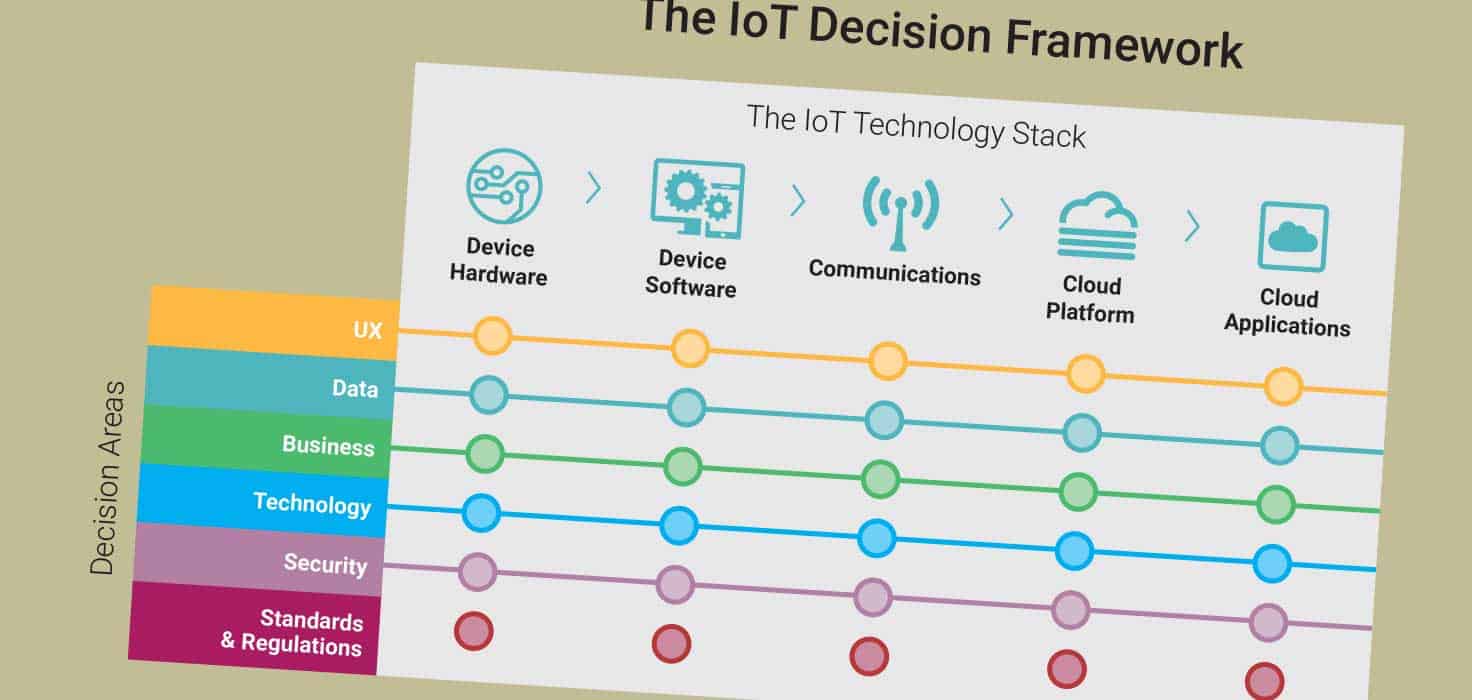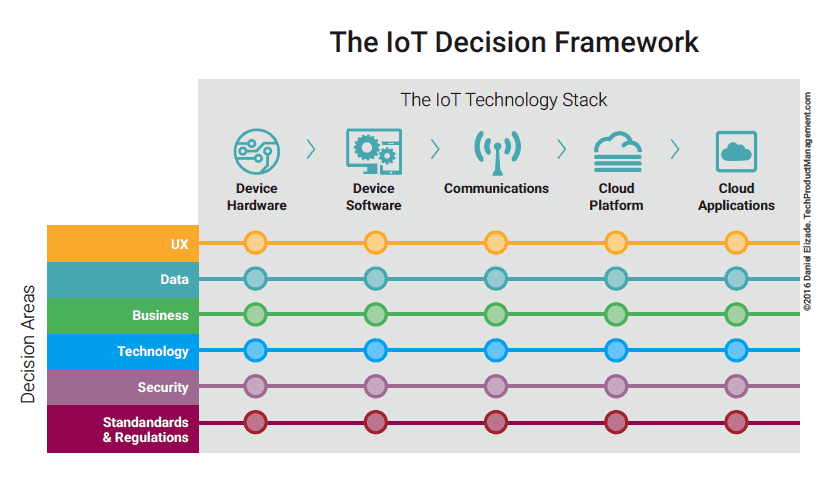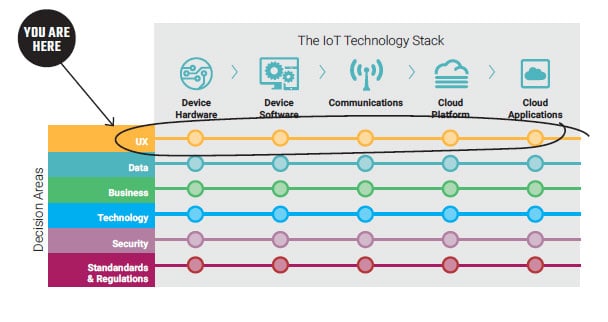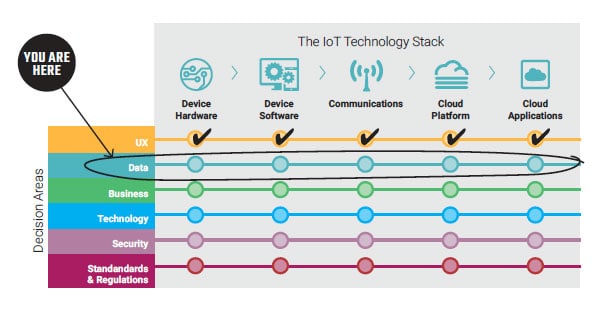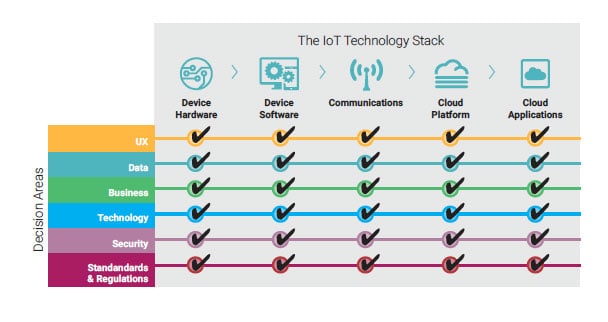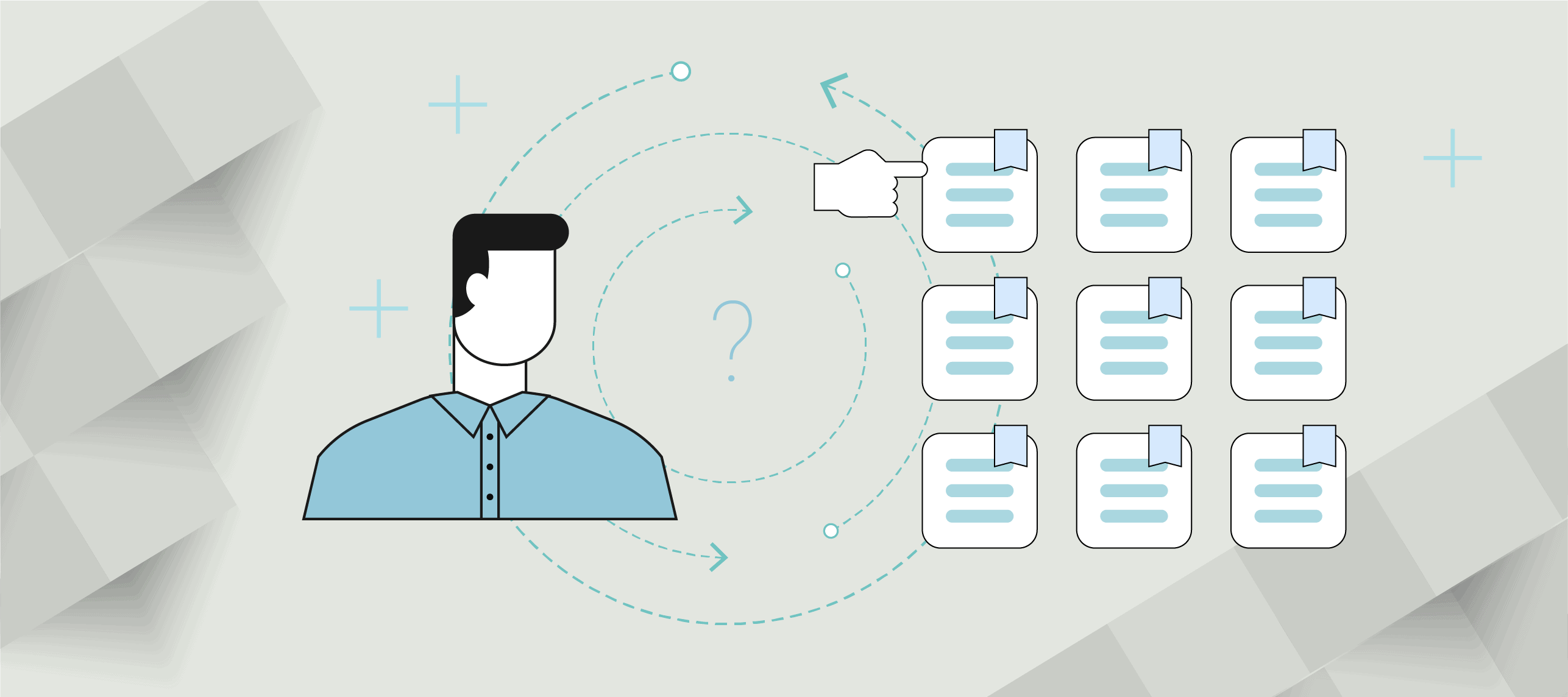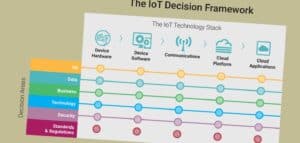
IN THIS ARTICLE, I PRESENT AN IOT FRAMEWORK to help Product Managers tackle the complexity of IoT products. This framework provides an easy-to-follow structure to uncover requirements at each layer of the IoT stack, including business decisions, technical decisions, and more.
Product management for an Internet of Things (IoT) product can be very daunting and confusing, even for the most seasoned product managers. That’s because IoT products are more complex than your average product since you need to consider the complexity of five layers of technology: device hardware, device software, communications, cloud platform, and cloud applications.
Not only do you need to make critical business and technical decisions at each of these five layers, but you also need to make sure this myriad of decisions is consistent with your overall strategy and consistent across the five layers. This exponentially increases the difficulty of managing an IoT product.
To help Product Managers tackle this complexity, I developed an IoT Decision Framework, which provides a structured approach to creating a robust IoT product strategy. What I mean by that is, this strategy is all about making decisions. The IoT Decision Framework helps you understand the areas where you need to make decisions and ensures consistency across all of your strategic decisions.
My IoT framework will help you uncover pitfalls early on before you have invested time and money in the wrong direction with your product.
I’ve seen it firsthand when seasoned product managers from top Silicon Valley companies attend my IoT strategy courses, either online or at Stanford University, as well as with my consulting clients.
Throughout my courses, participants drastically alter their product strategies as they work through the IoT Decision Framework. It helps them uncover questions they otherwise would not have considered—questions that could make or break their products.
To get started with the IoT Decision Framework, let’s take a look at the five layers of the IoT Technology Stack.
The 5 Layers of the IoT Technology Stack
The greatest challenge of managing an IoT solution is that there are five layers in the IoT technology stack, and decisions need to be made at each layer.
In a previous article, “Internet of Things: A Primer for Product Managers,” I describe these five layers in detail. For reference, the five layers are device hardware, device software, communications, cloud platform, and cloud applications.
To put things in perspective, a SaaS application only includes two layers: cloud platform and cloud applications. Those two layers alone are usually enough to keep any product manager on their toes. So you can imagine how adding three extra layers becomes exponentially more complex because you have to make decisions at each of these layers and make sure your decisions are consistent across all five layers.
As an IoT product manager, it can be very daunting to know where to start or how to organize your thoughts. One of the hardest parts is knowing which questions you should be asking.
The Solution: An IoT Framework for Product Managers
The IoT Decision Framework provides you with a structured approach to uncover the questions you need to ask and navigate across the various departments to make the best decisions for your product. Think of it as a map to help you discover all the necessary considerations as you build your IoT business plan, roadmap, backlog, etc.
The IoT Decision Framework focuses on six key decision areas you need to consider for any IoT product. These areas are user experience (UX), data, business, technology, security, and standards and regulations.
Each of these decision areas must be evaluated at each layer of the IoT technology stack. You’ll start with UX and work with your teams to discover what makes for a great user experience at the device hardware layer, then at the device software layer, and so on.
Then you can move to the data decision area and explore data considerations for your device hardware, data considerations for your device software and so on.
Once you are done with the data decision area of the IoT framework, you can move to the business decision area. You get the idea. Continue through the framework left to right and top to bottom until you cover all areas.
I know this sounds like a lot of work, and it is. But believe me, you’ll be glad you spent the time thinking about the implications of all decision areas throughout the IoT stack before you start building anything. That’s how you’ll create a consistent product strategy and learn about all the gaps that need further refining.
Each bubble in the IoT Decision Framework is an opportunity to use product management tools to make decisions and discover gaps—tools like market research, design research, customer development, prioritization, Lean, NPI, etc. This framework is not a replacement for any of those. On the contrary, it provides you with a map and a structure for your discovery process.
The Decision Areas of the IoT Decision Framework
It is very important to go through the IoT framework in order. Each of the decision areas is organized so that the information you collect in one area informs the subsequent area. I recommend you start with the UX decision area because your goal is to understand your user’s needs first and then move to the other decision areas.
Let’s take a closer look at each decision area of the IoT framework.
1. User Experience (UX) Decision Area
In this area, you need to understand who your user is, what their needs are and what would make for a great experience at each layer of the stack. Don’t worry about the technical details at this point. Just think about what this person wants, not how you will deliver it.
Plus, you’ll want to consider the needs of secondary users, like your internal fleet operations team, developer partners, sales team, installers, and more.
2. Data Decision Area
The goal of the data decision area is to help you define your overall data strategy. In a nutshell, you need to decide how data should flow through the stack to fulfill the user’s needs.
For example, what type of data does your device need to produce? How much data should be transmitted to the cloud and how often? Do you need to perform analytics at the edge, in the cloud, or both?
3. Business Decision Area
The goal of the business decision area is to help you determine whether your product idea has financial potential. In other words, will you be able to make money?
Based on the user and data decisions you made in the previous decision areas, you can now begin to make business decisions that will feed into your business plan and financial projections.
For example, you’ll need to decide your overall business model and which layers of the IoT technology stack you will monetize, as well as understand the costs of providing your service at each layer of the stack. You’ll also make critical business decisions such as whether to build or buy each layer of the stack and whether to open APIs.
4. Technology Decision Area
Based on the decisions you made in all previous areas, it is time to work with your technology teams to decide what technology is needed at each layer to deliver the final solution. The key here is not to choose the technology yourself, but to provide your engineering team the information and requirements they need to choose the best technical solutions.
Together with engineering, you’ll identify which sensors, device hardware, and device software are needed. You’ll design a communications topology and decide on communications protocols.
You’ll work with your team to choose a cloud platform based on data needs and performance requirements. And you’ll decide on the form factors of your cloud applications that best fit your user’s needs.
5. Security Decision Area
Once you’ve worked with your teams to select the implementation technology, it is time to decide how to secure each layer of the stack.
The goal of the security decision area is to help you think about how each layer could be compromised and how to respond when your devices are hacked. You’ll also need to decide whether you’ll implement security testing in-house or with a vendor, and how to protect your product from being hacked from inside your own company (by employees or unwanted guests).
6. Standards & Regulations Decision Area
During the last stage of my IoT framework, you’ll identify the standards and regulations that will affect your product at each layer of the stack, based on your type of product, customer, and industry.
For example, does your industry have a standard data format or communications protocol that will enable your product to talk to other devices? Do your customers require you to meet certain device safety or cloud security requirements? What laws must your product comply with at each layer?
##tweet##
Iterate, Iterate, Iterate
There are a lot of decisions that you will need to make during the life of your product. You can’t expect to get them all right in the first pass. Therefore, it’s important for you to iterate several times throughout the IoT Decision Framework to make sure you find a balance across all the areas.
The choices you make in each decision area and IoT technology stack layer will impact all of the other decision areas and stack layers. You’ll need to iterate several times across the framework before you reach a solution that is consistent with all the areas and has considered all the gaps.
For example, let’s say that in the data decision area, you decide that ideally, your product would provide real-time data to your user. In the business area, you outline the costs of providing device hardware, device software, and a cloud platform that can handle real-time data. And that’s when you realize providing this service will cost more than what your customer is willing to pay.
So you go back and decide that receiving data once per minute will be sufficient to meet your user’s needs. Then you work through the UX, business, and technology decision areas once again to make all your decisions consistent with the new once-per-minute approach.
An IoT product is more of a system than a stand-alone product. Everything is interconnected. By using this framework, you can make sure the decisions you make across all layers are consistent.
Questions to Ask at Each Decision Area
You may have noticed that in this post, I’m only including the IoT framework, and I’m not including a list of questions that you should answer in each decision area. That’s because the exact questions will depend entirely on your industry, application, and goals for the particular release you are working on.
For example, the questions you’ll need to answer for a brand new product or MVP will be very different from the questions you’ll need to answer for a mature product or even for a “version 2” product.
My IoT framework is intended as a tool to help you organize your thoughts and come up with the questions you need to answer as you develop your product strategy.
By the way, if you need more help figuring out the questions to ask or would like to go deeper, I recommend you check out my IoT courses for Product Managers. All of my IoT courses (either online or in-person) are built around the IoT Decision Framework as a way to help you and your team get a grip on your IoT product strategy fast.
How to Get the Most Out of the IoT Decision Framework
When to Use this IoT Framework
You should use this IoT framework after you have done the preliminary product work, including defining your target audience, detailing your value proposition, analyzing competitors, and estimating the revenue opportunity.
Once you have a solid idea of how an IoT product can add value to both your company and your customers, then you can use this IoT framework to guide you through the decisions you will need to make at each layer of the IoT technology stack to support your overall goals.
You can also use the IoT Decision Framework when you are:
- Creating your business plan
- Defining your MVP
- Building and managing your roadmap
- Defining new features
- Considering a product line extension
- Evaluating potential partnerships
- Analyzing the risks of changing any area of the technology stack
Work as a Team
Product managers are accountable for having a strong and consistent product strategy. But that doesn’t mean you should make your decisions in isolation. This IoT framework gives you an opportunity to collaborate with various departments to develop a common understanding of what the product will be.
Start by identifying who needs to be involved in creating your product strategy. Lead strategy workshops to make sure everyone is aligned; host working sessions with various departments (UX, engineering, finance, etc.) to gather information, generate questions for the framework, and discuss options; and get feedback from stakeholders and executives.
The result will be a stronger, more consistent strategy and a deeper level of support from your peers and executives.
The Bottom Line
IoT products are more complex than most other technology products. Using the IoT Decision Framework can help you organize your thoughts, identify opportunities and pitfalls, achieve consensus, and release the right solution faster. Download the IoT Framework here.
This article is republished with permission from Daniel Elizalde. You can hear Daniel discuss IoT’s impact on business as well as potential blind spots in the Pragmatic Live podcast.
Author
-
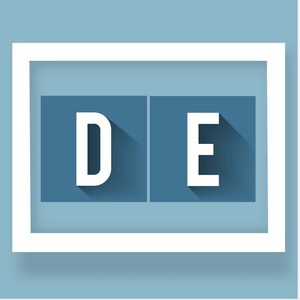
Daniel Elizalde, a veteran product coach and advisor with 25 years of experience, has made impactful contributions at National Instruments, Ericsson, and Stanford University. As a product executive, he leverages SaaS and IoT to drive innovation in diverse industries, including climate tech, eCommerce, and semiconductors. Daniel's career spans roles at Aeroflex Company, Projekt202, Volusion, and Stem, Inc. For questions or inquiries, please contact [email protected].
View all posts

